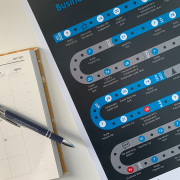What happens if a key employee or one of the part-owners in your business becomes critically ill or dies? It’s a question nobody likes to think about. In fact, only six per cent of Australian small businesses have insurance to safeguard their operations from the loss of an important staff member.i

Key person cover is one way to protect your business in this situation, as it provides a lump sum if an essential employee or part-owner suffers a critical illness, is permanently disabled, or dies.
If your business loses a key person for any of these reasons, the policy proceeds will become available to help overcome the difficulties and financial losses that can follow. In some cases, it may mean the difference between your future business success and failure.
How does it work?
Just as you take out insurance to protect your business assets like plant, equipment and premises, key person insurance is designed to protect the business’s human assets.
Generally, key person insurance uses traditional personal insurance covers to help your business cope with the impact of losing a key employee. Your business receives a life insurance benefit if the insured employee dies, a Total and Permanent Disablement (TPD) payout if the insured person suffers a disability, and trauma benefits if the insured suffers a trauma condition listed in the policy.
Unlike traditional personal protection policies, the premiums for key person policies are paid by the business – not the insured person – and the company receives the payout from the insurer.
Money to keep the doors open
If a key person becomes ill or dies, the proceeds from the insurance policy are designed to help the business pay expenses like recruiting and training a replacement employee, guaranteeing a new loan, settling debts, or making severance payments if the business closes.
The benefits can also compensate the company for any financial or capital value losses and help stabilise its financial position.
Another important use is to help fund a transition to new ownership. If a part owner dies unexpectedly, the insurance payment can be used in conjunction with a buy/sell agreement to allow the remaining owners to buy out the part-share held by the deceased’s beneficiaries.
Who is a key person?
Under this type of insurance policy, a key person is someone directly associated with the business who provides significant economic gain and whose loss would cause financial difficulties.
This is usually someone directly responsible for bringing in sales or with technical expertise on which the business is reliant. It typically includes the managing director, senior sales manager and financial controller.
Even a lower level employee with strong relationships with major clients, or specialist knowledge needed for the business to continue operating may be considered a key person.
Sole traders and one-person incorporated businesses are generally not able to insure themselves as a key person. When quoting a premium for this type of cover, insurers consider the amount of cover and the key person’s age, health and occupation.
In Australia, key person insurance polices are usually available for amounts between $500,000 and $10 million.
Tax benefits are available, maybe
The ATO recognises the value of key person cover and in many cases premiums are tax deductible. However, it is a complex area and deductibility depends on whether the policy is used for revenue purposes (deductible) or capital purposes (non-deductible).
Revenue purposes include replacing lost income or profits, while capital purposes include compensation for loss of goodwill or a lump sum payment to the deceased’s estate. You also need to be careful about the way you structure your key person policy to ensure the proceeds received are not assessable or subject to capital gains tax.
Let’s stay in touch
Sign up to our monthly newsletter to receive due dates, news, tax tips and other important things that we think are useful and interesting.
This article was written by a third party.
i BT/Westpac Life, www.bt.com.au/KPI










